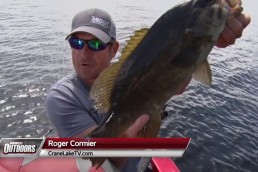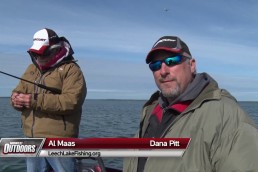It’s ‘Hammer Time’ for Big Kings on the Big Lake
SHARE THIS POST
We’ve been talking about it for months now, and so far every prediction has come true. The brown trout did not disappoint in March, with some outstanding catches of the silver footballs coming by mid-month as soon as the launches opened up. Lake trout were prevalent in April, along with the browns and then steelhead spawning early in the tributaries. These have been available to lake trollers earlier than most years.
And then there are the kings.
It has been a warm, early spring. In 2012, the first limit of 20 king salmon hit the docks in Algoma, Wis. on May 1—both early and unusual. But will it happen again? All indications are this is shaping up to be once again, a potential “Hammer Time” on big kings. Most “average” years, I often catch some of my biggest in June. When large schools of baitfish are around and kings are feeding, larger, aggressive fish will often outbattle smaller, medium-sized kings—and occasional big kings will come.
The above-average temperatures in winter coupled with a very early spring have kept the lake’s surface temperatures from chilling down like a “normal” season. While the surface temps dip down to the mid-30s, on a normal winter, that layer of 30-degree water “grows” thick, sometimes 20 to 30 feet down. That’s a lot of water mass to heat up in spring to get a lake to turn over. This year, that top layer of cold water is less than the norm, and may only be 5 to 10 feet thick in areas. That means a few calm, sunny days, and it’s game on for early king action.
This year, I saw anglers launching 16-, 18- and 21-foot boats in large numbers and boxing large numbers of browns before St. Patty’s Day. This was early for hot action and it continued through April, with lake trout and an occasional steelhead and a few kings showing up in shallow waters. This led me to the conclusion that as the water temperatures on the surface crept up to the mid-40s, Mother Nature would eventually do her springtime exchange of bottom and surface water much earlier than normal.
A lake will do an annual turnover early, and in the process, set up thermoclines on the surface suspended through the layers. This will also trigger the alewife, a small baitfish preferred by kings, to make their annual journey from deeper water toward shore for their spawning run. Now, the kings that spent most of the winter months in deeper waters closer to their food source will follow the alewife shoreward, once again providing line-ripping, hard-pulling action for anglers.
Are you enjoying this post?
You can be among the first to get the latest info on where to go, what to use and how to use it!
As this species settles in nearshore areas in the cooler spring waters, you can expect to put your equipment to the ultimate test. These hard-fighting kings will rip off long runs and pound your sets as they proceed to put the feedbag on after a winter of slower feeding.
As the water temperatures rise, so does a fish’s metabolism, and it will smoke your baits with reckless abandon. I made sure my Abu Garcia Alphamars were spooled with Trilene Professional Grade Braid with new fluorocarbon leaders. It is also important to keep my drags checked so that I don’t set them too tight when that big king decides to pound my glow-spoon behind the slide diver and rip out 100 yards of line in the dark and hang on for the impending fight.
This spring will be great fishing, and my money is on an early arrival of this salmon. With a mild winter and the early arrival of spring, expect to see surface temperatures rise and the lake turnover early, signaling kings to jump into feeding mode early. And head to the shores of north-central Lake Michigan and experience some battles with those giant kings.
Capt. Lee Haasch is a charter captain out of Algoma, Wis. Capt. Lee has over 40 years of Great Lakes angling experience and has been instructing anglers for over 25 years with education seminars and timely freelance articles in outdoor publications. For current fishing reports or information on charter fishing, check out Capt. Lee Haasch’s report page at FishAlgoma.com.
Tip of the Month
Fishing early in the summer as water warms up, is generally in the top layers of the lake strata. Most actively feeding fish will be in the top 60 feet, with the majority in the top 30 feet. Early-morning, low-light fishing is always good, but what about when the sun gets higher in the sky and the lake is calm? Ever notice how your downriggers and diver sets work well early, but fade to nothing as the sun rises? Try running longer leads on your downrigger sets. And instead of usual divers and planers, try running Slide Divers with Lite Bite feature. With these, you can lengthen out your leads. In shallow-water sets, I sometimes run 80- to 100-foot leads and my Slide Diver rigs become studs. With calm water and bright sun, your boat casts a shadow in the water that spooks fish. Get your sets farther away from the boat (deeper or farther) and you will increase your catch during bright daylight hours, plus the Lite Bite feature makes your divers release on the slightest bite.
MWO
SHARE THIS POST
Did you enjoy this post?
You can be among the first to get the latest info on where to go, what to use and how to use it!
Lee Haasch
Capt. Lee Haasch is a charter captain out of Algoma, Wis., with more than 45 years of Great Lakes angling and guiding experience. Haasch has been instructing anglers for over 30 years with education seminars and timely freelance articles.



